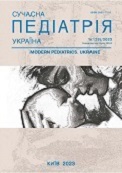A clinical case of infantile papular acrodermatitis or Gianotti-Crosti syndrome
DOI:
https://doi.org/10.15574/SP.2023.129.95Keywords:
children, papular acrodermatitis, Gianotti-Crosti syndrome, viral exanthemAbstract
Gianotti-Crosti syndrome is a kind of infectious exanthem. That is characterized by the appearance of monomorphic papules, which colour may be from the skin colour to pink-red ones. The most typical location is on the face, buttocks and extensor surfaces of the limbs. Over time, the rash disappears spontaneously and the medical treatment becomes symptomatic. Currently, the pathophysiological changes are not still thoroughly studied. It is clear that the syndrome represents an immunological response to the previous viremia and bacteraemia; perhaps, it is the delayed-type hypersensitivity reaction.
Purpose - to acquaint doctors with criteria of the papular acrodermatitis for a timely diagnostic and a correct treatment strategy.
Clinical case. There was a described clinical case of Gianotti-Crosti syndrome in a child of 2. The parents had complained about rashes on the face, limbs, buttocks for 6 weeks. The severe restlessness and itching of the skin had been present. During the whole time, the child was examined by various specialists. Alternative diagnoses were: an atopic dermatitis, a food allergy, a worm infestation. The child was prescribed local zinc-containing agents, systemic and local glucocorticosteroids, antiviral drugs, antibacterial therapy, antihistamines, sorbents, probiotics and a three-time course of deworming in the process of the treatment. The treatment have not had a positive therapeutic effect.
Conclusions. Gianotti-Crosti syndrome is most common in childhood. At present, we consider it a self-limited disease that does not require specific treatment. Recent studies proved that the syndrome is more commonly associated with a variety of viral and bacterial pathogens. However, insufficient knowledge of papular acrodermatitis may lead to groundless and continuous examinations and treatment of children.
The research was carried out in accordance with the principles of the Helsinki Declaration. The informed consent of the patient was obtained for conducting the studies.
No conflict of interests was declared by the authors.
References
Chuh A, Zawar V, Sciallis GF. (2015). The diagnostic criteria of pityriasis rosea and Gianotti-Crosti syndrome - a protocol to establish diagnostic criteria of skin diseases. Journal of the Royal College of Physicians of Edinburgh. 45 (3): 218-225. https://doi.org/10.4997/jrcpe.2015.310; PMid:26517103
Drago F, Javor S, Ciccarese G. (2016). Gianotti-Crosti syndrome as presenting sign of cytomegalovirus infection: A case report and a critical appraisal of its possible cytomegalovirus etiology. Journal of clinic virology. 78: 120-122. https://doi.org/10.1016/j.jcv.2016.03.009; PMid:27017141
Imoto RR, Uber M, De Carvalho VO. (2019). Papular crusted rash in a child after immunisation. Archives of Disease in Childhood. 104 (7): 706. https://doi.org/10.1136/archdischild-2018-314922; PMid:29728416
Kliegman R, Geme JSt. (2019). Nelson Textbook of Pediatrics. Elsevier: 4264.
Pedreira RL, Leal JM, Silvestre KJ. (2016). Gianotti-Crosti syndrome: a case report of a teenager. Anais Brasileiros Dermatologia journal. 91 (5): 163-165. https://doi.org/10.1590/abd1806-4841.20164410; PMid:28300930 PMCid:PMC5325029
Stojkovic-Filipovic J, Skiljevic D, Brasanac D. (2016). Gianotti-Crosti syndrome associated with Ebstein-Barr virus and Parvovirus B-19 coinfection in a male adult: case report and review of the literature. Italian Journal of Dermatology and Venereology. 151: 106-107.
Usachova OV. (2017). The role of enterovirus infections in the development of exanthematous disease in children: clinical and epidemiological features and the possibilities of drug correction. Sovremennaya pediatriya. 5 (85): 19-24. https://doi.org/10.15574/SP.2017.85.19
Downloads
Published
Issue
Section
License
Copyright (c) 2023 Modern pediatrics. Ukraine

This work is licensed under a Creative Commons Attribution-NonCommercial 4.0 International License.
The policy of the Journal “MODERN PEDIATRICS. UKRAINE” is compatible with the vast majority of funders' of open access and self-archiving policies. The journal provides immediate open access route being convinced that everyone – not only scientists - can benefit from research results, and publishes articles exclusively under open access distribution, with a Creative Commons Attribution-Noncommercial 4.0 international license (СС BY-NC).
Authors transfer the copyright to the Journal “MODERN PEDIATRICS. UKRAINE” when the manuscript is accepted for publication. Authors declare that this manuscript has not been published nor is under simultaneous consideration for publication elsewhere. After publication, the articles become freely available on-line to the public.
Readers have the right to use, distribute, and reproduce articles in any medium, provided the articles and the journal are properly cited.
The use of published materials for commercial purposes is strongly prohibited.

